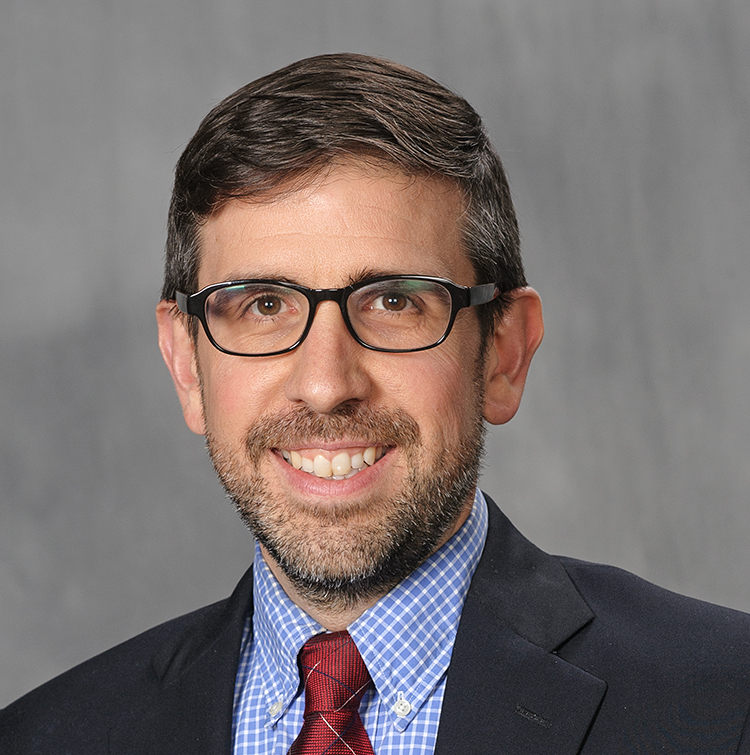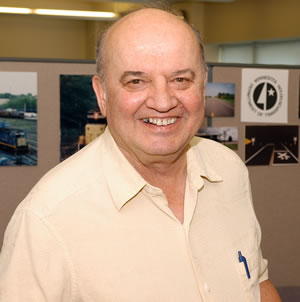 |
|

|
 |
TABLE of CONTENTS
 |
When the Capitol goes quiet: Government Affairs adapts to COVID-19 |
By Joseph Palmersheim
 Legislative Affairs Manager John Dukich gets a little help from his daughter, Aurora, after watching a hearing and composing an email. Photo courtesy of John Dukich. Legislative Affairs Manager John Dukich gets a little help from his daughter, Aurora, after watching a hearing and composing an email. Photo courtesy of John Dukich.
|
During a typical May, Minnesota’s Capitol is humming with the sounds of legislating, working up to a crescendo at the end of the month when session ends.
This May isn’t typical. The state’s response to COVID-19 has changed the look and feel of what would otherwise have been a time filled with a flurry of legislative committee hearings, lengthy House and Senate floor sessions, and the rush of lobbyists and advocates packing the Capitol.
Like many other offices at MnDOT, the Government Affairs team is working remotely, with meetings occurring over Skype.
“The biggest challenge we face is working remotely in an occupation where in-person contact and meetings are a key aspect of the job,” said John Dukich, legislative affairs manager. “Not being at the Capitol, especially during the push toward the end of the legislative session, is certainly a challenge. There is a certain buzz around the Capitol this time of year that is currently absent.”
Legislators, too, have been primarily working remotely, with the occasional meeting in-person during House or Senate floor sessions. These interactions have moved to Zoom or phone. Commissioner Margaret Anderson Kelliher and Government Affairs Director Erik Rudeen have testified remotely at various committee hearings, allowing the agency to provide input during committee hearings.
One highlight from the session was enactment of a Transportation Infrastructure Finance and Innovation Act bill to extend Hwy 14 from two lanes to four lanes between Nicollet and New Ulm. The bill provides for a loan, agreements and loan repayment involving federal transportation funding assistance.
“This was a major accomplishment, especially considering it was passed just before the Legislature left St. Paul at the beginning of the Stay-at-Home order,” Rudeen said.
The House released its bonding bill May 11, which passed the Ways & Means Committee May 12, and includes $452 million for MnDOT. The Senate has not released a bonding bill yet.
The omnibus policy bill includes two MnDOT initiatives - trunk highway turn backs and motor carrier regulations.
The turn backs proposal allows MnDOT to turn jurisdiction of Trunk Highway 237 over to Stearns County. It also makes a correction to a turn back enacted last year for Trunk Highway 156 in Dakota County and South St. Paul. Turn backs serve the public by assigning roads to the jurisdictions best able to effectively and efficiently operate them. For example, a road of low priority on the state system is typically given higher priority on the county system. The transfers typically include funding for improvement or repairs to the road prior to transfer.
The motor carrier proposal clarifies MnDOT’s authority to enforce background checks on special transportation service drivers, modifies law governing issuance of STS decals and makes other technical changes to STS law. MnDOT became responsible for regulation of STS providers in 2016. Since then, the agency has identified several places where statutes are out-of-date. Additionally, there are some unintended consequences from previous legislation that limit MnDOT's ability to enforce certain requirements, such as when providers or drivers are operating without having passed a background check.
The regular session ends May 18. The long-term impact from COVID-19 remains to be seen, Dukich said, adding that it is possible that the Legislature would continue to meet over the summer in Special Session to address the COVID-19 emergency.
“The uncertainty over how COVID-19 will continue to evolve and its health and economic impacts creates uncertainty in its impact on the Legislature, and in turn, Government Affairs. With the Legislature largely focused on legislation addressing the COVID-19 crisis, some less critical issues that might have otherwise been addressed must be left for another time.”
|
 |
|

|
 |
TABLE of CONTENTS
 |
Employees help deliver food to tribal nations |
|
By Rich Kemp

Andrea Heimerl, Anoka truck station, and Eric Sandeen, Cedar Avenue truck station, helped deliver food to tribal nations April 30. It was part of a mission from the State Emergency Operations Center. Photo by Rich Kemp |
MnDOT employees recently volunteered to support a food delivery mission to four tribal nations on April 30 and May 1. MnDOT supported the mission with 12 drivers and the Department of Natural Resources provided three drivers in response to the State Emergency Operations Center request.
“It’s not a normal mission, but overall it went great,” said Jacob Beauregard, SEOC logistics section chief.
The drivers picked up the food April 30 at Second Harvest Heartland in Brooklyn Park. Four trucks delivered food to White Earth Nation in Mahnomen and four trucks took food to Leech Lake Band of Ojibwe in Cass Lake. Mike Holway, Arden Hills truck station; Eric Sandeen, Cedar Avenue truck station; Ray Reeder and Troy Johnson, Anoka truck station; and Corey Hansen, Plymouth truck station, drove box trucks filled with food to the tribal nations. Andrea Heimerl, Anoka truck station, and David Thurmes, Hastings truck station, followed behind in trail vehicles.

From left: Corey Hansen, Plymouth truck station; Troy Johnson, Anoka truck station, and Mike Holway, Arden Hills truck station, participated April 30 in a State Emergency Operations Center mission to deliver food to tribal nations. Photo by Rich Kemp |
Six more trucks delivered food on May 1. Two went to Lower Sioux Indian Community in Morton, and four to Mille Lacs Band of Ojibwe in Onamia. Sam White, Cedar Avenue truck station; Andrew Bilek, Forest Lake truck station, and Darren Trast, Maryland Avenue truck station, drove the box trucks to the tribal nations. David VanHeel, Oakdale truck station, and James Thompson, North Branch truck station, drove the trail vehicles.
“The success of the mission is a direct result of the strong working relationships and cooperation between Minnesota’s state agencies, local jurisdictions and non-profits/non-governmental organizations,” Beauregard said.
The teams met at the Shoreview Training and Conference Center and then picked up the food at Second Harvest Heartland.
|
 |
|

|
 |
TABLE of CONTENTS
 |
Hwy 61 construction making progress in Lake City |

A drone shot of the Hwy 61 reconstruction project in Lake City. The $14.6 million project spans through downtown Lake City along the waterfront. Photo by Ben Threinen |
By Sheila Thoma, District 6 Public Affairs
The typical excitement of spring in Lake City is for the coming boating season on Lake Pepin, but this year, it’s also because the Hwy 61 reconstruction project in Lake City is underway.
The $14.6 million project spans through downtown Lake City along the waterfront. It is replacing deteriorated pavement, some portions of which are 95 years old. The four-lane highway is also being reduced to three lanes, which will result in safer traveling speeds.
Improved pedestrian and cyclist elements are also part of the project. A continuous sidewalk system will provide for a better and safer experience for the 3,300 feet of roadway without sidewalks. A multiuse off-street trail and green space will be a boost for residents and visitors enjoying the region’s popular marina. The city boasts that it is where water skiing was invented and holds a community festival, Water Ski Days, to celebrate it each summer.
“Living in the Lake City area and being on the MnDOT planning team has made my involvement in this project especially interesting,” said Aaron Breyfogle, senior project development engineer. “The waterfront improvements not only will make it a safer area, it will also enhance visual aspects resulting in a better experience for the Lake City community and tourists.”
Because this is a downtown project with intense community debate, the MnDOT public engagement efforts have been significant. The city council chose the four-lanes-to-three-lanes option after considerable discussion. From community meetings to individual conversations with businesses and residents, the District 6 team strategically focused on building relationships during planning.
The public communications and interactions have been a collaborative effort and continues to be with the District 6 team, Lake City, Lake City Chamber of Commerce, Lake City EDA and the contractor. Now that the project has started, communications efforts continue with project updates through weekly virtual public meetings, detailed website information, weekly emails and social media postings.
The contractor, Rochester Sand & Gravel, was able to start earlier than scheduled, taking advantage of the reduced traffic due to Gov. Tim Walz’s Stay at Home order to reduce the spread of COVID-19.
The project is scheduled to be complete in October.
|
 |
|

|
 |
TABLE of CONTENTS
 |
Upgrade to Remedy ticket application coming in June |
By Joseph Palmersheim
Next month, MNIT will roll out an enhanced application for reporting information technology issues. Remedy will now be known as Helix.
Users will continue to use the IT Storefront (the golden surfer) to submit an IT ticket, but once inside the IT Storefront, forms and screens are now branded as the Minnesota Service Hub. The move stems from several DOT IT services being optimized in July 2019 with MNIT, creating an enterprise-wide support model.
“MNIT offers Remedy, which will now be known as Helix, as a service paid for as part of rates, so it is no longer necessary for MNIT@DOT to host and support their own version,” said Matthew Netland, Service Delivery Director with MNIT Enterprise. “Helix will provide many new features and functions that will benefit both end users and IT. Eventually all executive branch state agencies will be using Helix. This will provide consistent reporting and allow agencies to share knowledge.”
Other benefits of the change include additional features to improve the reporting environment, enhanced accessibility features, additional capability for the mobile workforce, and user customizations. The migration to the Helix environment aligns with MnDOT and MNIT’s modernization, preservation, optimization and shared service strategies, Netland said.
At this point, users do not need to make any updates. Additional project information, including scheduled orientation and training sessions for technical and non-technical business users, will be distributed within the next few weeks.
If you have questions or concerns, contact Victoria Hopwood, Shailee Shrestha, or Greg Ruhland.
|
| |
|

|
 |
TABLE of CONTENTS
 |
New library materials posted on the web |
New library materials are available at mndot.gov/library/newlibmat.html. In addition to the list of newly cataloged materials by subject, this issue features the new statewide book club “One Book|One Minnesota,” as well as digital resources available to MnDOT employees.
New Library Materials is a compilation of new titles and other resources added to the library collection during the previous month. Email MnDOT Library or send requests via the Ask a Librarian webpage for questions or to be added to the distribution list.
|
 |
|

|
 |
TABLE of CONTENTS
 |
Staffing updates |
By Joseph Palmersheim

Ryan Gaug. Submitted photo |
Ryan Gaug is the new assistant office director for the Office of Aeronautics, effective May 13.
Gaug, a 12-year-MnDOT employee, served in that role for seven months in a work-out-of-class status before being made permanent. Before that, he served as planning director in Aeronautics since 2014. Prior to joining MnDOT, Gaug worked as a legislative aide in the U.S. Congress, both in Washington, D.C., and in district offices.
Gaug earned an undergraduate degree in political science from Wittenberg University and a master’s degree in Urban and Regional Planning from the Humphrey School of Public Affairs, University of Minnesota. He is certified by the American Institute of Certified Planners.

Heidi Henry. Submitted photo |
Heidi Henry is MnDOT’s new transportation audit director. Her first day on the job was April 15.
Prior to this role, Henry served MnDOT as an agency grant supervisor (2015-2020) and as an internal control specialist (2011-15). In addition, she recently completed Emerging Leaders Institute and has been through the Leadership Development Program, SEAL, Kaizen and advanced project management trainings.
Henry holds a double major from the College of St. Catherine in accounting and communications, as well as a Certification in Control Self-Assessments.

Nicole Campbell. Submitted photo |
Nicole Campbell has been hired as the new ABC Ramps coordinator. Her first day was April 8.
Campbell is returning to MnDOT from Wenatchee, Wash., where she was the senior transportation planner with the Chelan-Douglas Transportation Council. She was part of MnDOT’s Office of Transit and Alternative Transportation team prior to moving to Washington State to work as a transportation planner in Seattle.
She has a bachelor’s degree in cultural anthropology from Western Washington University, and a master of urban and regional planning degree from the Humphrey School of Public Affairs, University of Minnesota. She is certified by the American Institute of Certified Planners.
|
 |
|

|
 |
TABLE of CONTENTS
 |
Remembering George Thibault, 63-year MnDOT employee |
By Joseph Palmersheim

George Thibault, who worked for MnDOT for more than 63 years, died on May 2. Photo by David Gonzalez |
George Thibault, who worked for MnDOT for more than 63 years, died on May 2. He was 85 years old.
Thibault started in June 1953 as a construction laborer in in the districts. During his career, he worked in traffic engineering (1959-1969) and helped develop MnDOT’s first traffic engineering manual. He also worked in Land Management, Freight and Commercial Vehicle Operations, and Management Data Services, retiring from full-time work in 1997. He continued working part-time at MnDOT until January 2017.
George met Kaye, his wife of 27 years, when she started working for MnDOT in 1986. She now works for MN.IT Partnering with Transportation. They married in 1992.
“George enjoyed the idea of public service, working for the greater good,” Kaye said. “He loved that he could work in so many different areas from districts to Central Office, from construction to office work, from raw materials to technology like GIS. He was a real people person. He missed all the wonderful people that he got to work with.”
Thibault was one of three 50-year career employees featured in a 2006 Newsline article that marked a half-century of the interstate system and recognized the people who made it happened.
Thibault was interred at Fort Snelling National Cemetery. He is survived by Kaye Thibault, five children and eight grandchildren.
|
 |
|

|
 |
TABLE of CONTENTS
 |
On the Job: Shannon Foss develops MnDOT’s Transportation Asset Management Plan |
By Rich Kemp
Shannon Foss started with MnDOT nine years ago and serves as an asset management planning director. We caught up with her recently to learn more about her job. The image below is linked to a larger version.

Do you or a co-worker have an interesting job to share with readers? Send us your ideas, and we’ll contact you for more information.
Recent employee profiles:
|
 |
|

|
 |
TABLE of CONTENTS
 |
Veterans reflect on meaning of Memorial Day |
By Anthony Cenci
Before I say what Memorial Day means to me, here are some things you may or may not have known about some of the history of this practice.
- The practice of honoring the dead from war goes back thousands of years.
- One of the earliest known public tributes occurred in 431 B.C when Athenian general Pericles delivered a funeral oration praising the sacrifice and valor of those killed in the Peloponnesian War.
- In May 1868 General John A. Logan, the commander and chief of the Union Veterans group issued a decree that May 30 (Decoration Day) should become a nationwide remembrance day of the more than 620,000 soldiers killed in the recently ended Civil War. Legend says that General Logan picked this day because it didn’t fall on the anniversary of a Civil War battle. Historians say that the date was picked because flowers would be in full bloom across most of the nation.
- It didn’t become a Federal Holiday until 1971.
- The term “Memorial Day” was used beginning in the 1880s. The holiday was officially known as Decoration Day for more than a century until it was changed by Federal Law; four years later the Uniform Monday Holiday Act of 1968 went into effect, moving Memorial Day from its traditional observance on May 30 (regardless the day of the week) to the last Monday in May. (This move is still controversial with many veterans groups, worried that people look at it more as the first long weekend of summer as opposed to honoring the nation’s war dead and original purpose).
- Cultures all over the world practice this in one form or another. There are too many to list here, but I encourage everyone to research it.
So before I say what Memorial Day means to me, it can’t be understated that Memorial Day means different things to different generations - think of the difference in how WWII veterans and Vietnam veterans were treated when they came home, or service members returning home from the Korean War to be told it wasn’t a war that their friends died fighting, but a “conflict.” Even among the Veterans within those three groups there are differing opinions. Politics is the reason this practice exists, but it doesn’t define it.
On Memorial Day, I reflect that the human cost of war is high and the necessity for it should be equally as high. That without people who are willing to give their lives to the benefit of strangers it cannot be taken for granted. I also acknowledge that many who have died fighting in wars, did so not of their own free will and not for the most absolute of moral reasons. I will leave you with this, the freedom of thought is the only true freedom anyone truly has and tyrants will always demand you give that up. Don’t ever lose sight of that.
Anthony Cenci, who works in the Office of Freight and Commercial Vehicle Operations, served in the U.S. Air Force from 2000-2005. He is a co-chair of the Veterans Employee Resource Group.
By Rebecca Neafus
At different points in my life, Memorial Day has brought about different images, emotions and practices. As a child, I had the view this was the real beginning of summer and delighted in the welcome thought of being out of the classroom, outdoors and gathering with more friends and family than other times. As a teenager, I started to become aware of something more somber associated with the holiday but still had my mind on graduations, celebrations and real hot-sand beach time. As a young adult, I started really listening with attention to those stories of veterans I heard first-hand from family or read about. A feeling of something larger started to take shape; duty, purpose, brotherhood, sacrifice and sorrow.
Eventually, when I was first looking at education and career options, I considered service an honorable option and enlisted. I learned over time that this brotherhood is really a camaraderie of real folks coming from every walk of life for their own reasons and having similar experiences but with unique perspectives. A lifelong bond and respect started to build up then grow. Time and circumstances take some of those friendships or lives from us. So we start to make time to remember. Remembering can be healing.
Today, I reflect on and embrace each one of these phases but mostly I remember, honor the sacrifice of lives lost, look to heal as a community.
Rebecca Neafus works as an executive assistant in the Chief of Staff Office. She served in the U.S. Air Force from 1987-1991. She is a member of the Veterans Employee Resource Group.
|
 |
|
| |
|



